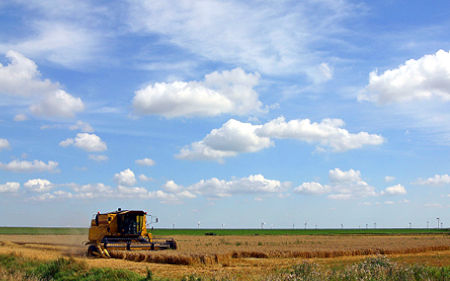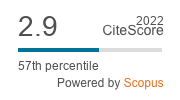The environmental effects of global changes on northeast central Europe in the case of non-modified agricultural management
DOI:
https://doi.org/10.3097/LO.200804Keywords:
Climate scenario, Crop production, Land use, Water balanceAbstract
Climate impact scenarios for agriculture usually consider yield development, landscape water balance, nutrient dynamics or the endangerment of habitats separately. Scenario results are further limited by roughly discriminated land use types at low spatial resolution or they are restricted to single sites and isolated crops. Here, we exemplify a well data based comprehensive sensitivity analysis of a drought endangered agrarian region in Northeast Germany using a 2050 climate scenario. Coherently modelled results on water balance and yields indicate that agricultural production may persist, whereas wetlands and groundwater production will be negatively affected. The average percolation rate decreases from 143 mm a-1 to 12 mm a-1, and the average yield decline broken down by crops ranges from 4% for summer wheat to 14% for potatoes (main cereals: 5%).
References
Addiscott, T. M., & Wagenet, R. J. (1985). Concepts of solute leaching in soils: A review of modelling approaches. Journal of Soil Science, 36(3), 411-424. doi:10.1111/j.1365-2389.1985.tb00347.x
Adler, G. (1987). Zur mesoskaligen kennzeichnung landwirtschaftlich genutzter standorte von pflanzenbaubetrieben. Zeitschrift Für Meteorologie, 37, 291-298.
Ainsworth, E. A., & Long, S. P. (2005). What have we learned from 15 years of free-air CO2 enrichment (FACE)? A meta-analytic review of the responses of photosynthesis, canopy properties and plant production to rising CO2. New Phytologist, 165(2), 351-372. doi:10.1111/j.1469-8137.2004.01224.x
Audsley, E., Pearn, K. R., Simota, C., Cojocaru, G., Koutsidou, E., Rounsevell, M. D. A., . . . Alexandrov, V. (2006). What can scenario modelling tell us about future european scale agricultural land use, and what not? Environmental Science and Policy, 9(2), 148-162. doi:10.1016/j.envsci.2005.11.008
Baldocchi, D., & Wong, S. (2006). An assessment of the impacts of future CO2 and climate on californian agriculture. A California Climate Change Center Report CEC-500-2005-187-SF,
Boden, A. G. (1994). Bodenkundliche Kartieranleitung,
Eulenstein, F., Olejnik, J., Willms, M., Chojnicki, B. H., & Urbaniak, M. (2005). The influence of land use on soil water balances under present and future conditions in north-eastern central europe. Integrated Land and Water Resources Management: Towards Sustainable Rural Development.Proceedings 21st European Regional Conference of the International Commission on Irrigation and Drainage.,
Eulenstein, F., Olejnik, J., Willms, M., Kersebaum, K. C., & Werner, A. (2003). Simulation des stofftransports in der ungesättigten zone. Handbuch Wasserversorgung Und Sulfatbelastung Des Grundwassers Unter Land- Und Forstwirtschaftlich Genutzten Flächen, , 110-117.
Ewert, F., Rounsevell, M. D. A., Reginster, I., Metzger, M. J., & Leemans, R. (2005). Future scenarios of european agricultural land use: I. estimating changes in crop productivity. Agriculture, Ecosystems and Environment, 107(2-3), 101-116. doi:10.1016/j.agee.2004.12.003
Friesland, H., Kersebaum, K. -., & Löpmeier, F. -. (1998). Operational use of Irrigation Models using Medium Range Weather Forecast,
Gedney, N., Cox, P. M., Betts, R. A., Boucher, O., Huntingford, C., & Stott, P. A. (2006). Detection of a direct carbon dioxide effect in continental river runoff records. Nature, 439(7078), 835-838. doi:10.1038/nature04504
Gerstengarbe, F. -., Badeadeck, F., Hatterman, F., Krysanova, V., Lahmer, W., Lasch, P., . . . Werner, P. C. (2003). Studie Zur Klimatischen Entwicklung Im Land Brandenburg Bis 2055 Und Deren Auswirkungen Auf Den Wasserhaushalt, Die Forst- Und Landwirtschaft Sowie Die Ableitung Erster Perspektiven PIK Report no.83.,
Haude, W. (1955). Zur bestimmung der verdunstung auf möglichst einfache weise. Mitteilungen Des Deutschen Wetterdienstes, 11(11), 1-24.
Heger, K. (1978). Bestimmung der potentiellen evapotranspiration über unterschiedlichen landwirtschaftlichen kulturen. Mitt.Dtsch.Bodenkd.Ges., 26, 21-40.
Kersebaum, K. C. (1995). Application of a simple management model to simulate water and nitrogen dynamics. Ecological Modelling, 81(1-3), 145-156. doi:10.1016/0304-3800(94)00167-G
Kersebaum, K. C. (1989). Die simulation der stickstoffdynamik von ackerböden. Die Simulation Der Stickstoff-Dynamik Von Ackerböden,
Kindler, R. (1992). Ertragsschätzung in Den Neuen Bundesländern,
Long, S. P., Ainsworth, E. A., Leakey, A. D. B., Nösbsrger, J., & Ort, D. R. (2006). Food for thought: Lower-than-expected crop yield stimulation with rising CO2 concentrations. Science, 312(5782), 1918-1921. doi:10.1126/science.1114722
Maracchi, G., Sirotenko, O., & Bindi, M. (2005). Impacts of present and future climate variability on agriculture and forestry in the temperate regions: Europe. Climatic Change, 70(1-2), 117-135. doi:10.1007/s10584-005-5939-7
Mirschel, W., Wieland, R., Voss, M., Ajibefun, I., & Deumlich, D. (2006). Spatial analysis and modeling tool (SAMT): 2. applications. Ecological Informatics, 1(1), 77-85. doi:10.1016/j.ecoinf.2005.10.004
Mirschel, W., Wieland, R., & Wenkel, K. -. (2003). Bedeutung der modellwahl bei der ertragsschätzung-bauernschläue vs. agrarwissenschaft. Theorie Und Modellierung Von Ökosystemen: Workshop Kölpinsee 2001, , 162-186.
Mirschel, W., Wieland, R., & Wenkel, K. -. (2006). Spatial analysis and modeling tool V2.0-applications to the landscape indicators crop yield and crop coverage. Eco-Info and Systems Research.Series: Systems Research, 52, 29-42.
Rounsevell, M. D. A., Reginster, I., Araújo, M. B., Carter, T. R., Dendoncker, N., Ewert, F., . . . Tuck, G. (2006). A coherent set of future land use change scenarios for europe. Agriculture, Ecosystems and Environment, 114(1), 57-68. doi:10.1016/j.agee.2005.11.027
Schimel, D. (2006). Climate change and crop yields: Beyond cassandra. Science, 312(5782), 1889-1890. doi:10.1126/science.1129913
Schmidt, R., & Diemann, R. (1991). Erläuterungen Zur Mittelmaßstäbigen Landwirtschaftlichen Standortkartierung (MMK),
Weigel, H. -., Manderscheid, R., Pacholski, A., Burkhart, S., & Jansen, G. (2005). Mehr CO2 in der atmosphäre: Prima klima für die landwirtschaft? Forschungsreport (Zeitschrift Des Senats Der Bundesforschungsanstalten), 1, 14-17.
Wendling, U., Schellin, H. -., & Thomä, M. (1991). Bereitstellung von täglichen informationen zum wasserhaushalt des bodens für die zwecke der agrarmeteorologischen beratung. Z.Meteorol., 41(6), 468-475.
Wessolek, G., & Asseng, S. (2006). Trade-off between wheat yield and drainage under current and climate change conditions in northeast germany. European Journal of Agronomy, 24(4), 333-342. doi:10.1016/j.eja.2005.11.001
Wieland, R., Voss, M., Holtmann, X., Mirschel, W., & Ajibefun, I. (2006). Spatial analysis and modeling tool (SAMT): 1. structure and possibilities. Ecological Informatics, 1(1), 67-76. doi:10.1016/j.ecoinf.2005.10.005
Wiggering, H., Eulenstein, F., & Augustin, J. (2005). Entwicklung Eines Integrierten Klimaschutzmanagements Für Brandenburg: Handlungsfeld Landwirtschaft (DS 3/6821-B),
Willms, M., Eulenstein, F., Olejnik, J., & Kersebaum, K. -. (2006). Simulation des schwefel-haushaltes von landwirtschaftlich genutzten böden mit dem modell SULFONIE. In: Land- Und Ernährungswirtschaft Im Wandel: Aufgaben Und Herausforderungen Für Die Agrar- Und Umweltinformatik,

Downloads
Published
How to Cite
Issue
Section
License
Copyright (c) 2019 Hubert Wiggering, Frank Eulenstein, Wilfried Mirschel, Matthias Willms, Claus Dalchow, Jürgen Augustin

This work is licensed under a Creative Commons Attribution 4.0 International License.










